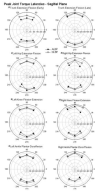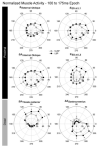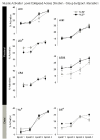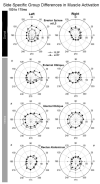Individuals with non-specific low back pain in an active episode demonstrate temporally altered torque responses and direction-specific enhanced muscle activity following unexpected balance perturbations
- PMID: 22875027
- PMCID: PMC3472522
- DOI: 10.1007/s00221-012-3183-8
Individuals with non-specific low back pain in an active episode demonstrate temporally altered torque responses and direction-specific enhanced muscle activity following unexpected balance perturbations
Abstract
Individuals with a history of non-specific low back pain (LBP) while in a quiescent pain period demonstrate altered automatic postural responses (APRs) characterized by reduced trunk torque contributions and increased co-activation of trunk musculature. However, it is unknown whether these changes preceded or resulted from pain. To further delineate the relationship between cyclic pain recurrence and APRs, we quantified postural responses following multi-directional support surface translations, in individuals with non-specific LBP, following an active pain episode. Sixteen subjects with and 16 without LBP stood on two force plates that were translated unexpectedly in 12 directions. Net joint torques of the ankles, knees (sagittal only), hips, and trunk, in the frontal and sagittal planes, were quantified and the activation of 12 muscles of the lower limb unilaterally and the dorsal and ventral trunk, bilaterally, were recorded using surface electromyography (EMG). Peaks and latencies to peak joint torques, rates of torque development (slopes), and integrated EMGs characterizing baseline and active muscle contributions were analyzed for group by perturbation direction (torques) and group by perturbation by epoch interaction (EMG) effects. In general, the LBP cohort demonstrated APRs that were of similar torque magnitude and rate but peaked earlier compared to individuals without LBP. Individuals with LBP also demonstrated increased muscle activity following perturbation directions in which the muscle was acting as a prime mover and reduced muscle activity in opposing directions, proximally and distally, with some proximal asymmetries. These altered postural responses may reflect increased muscle spindle sensitivity. Given that these motor alterations are demonstrated proximally and distally, they likely reflect the influence of central nervous system processing in this cohort.
Figures






Similar articles
-
Individuals with non-specific low back pain use a trunk stiffening strategy to maintain upright posture.J Electromyogr Kinesiol. 2012 Feb;22(1):13-20. doi: 10.1016/j.jelekin.2011.10.006. Epub 2011 Nov 18. J Electromyogr Kinesiol. 2012. PMID: 22100719 Free PMC article.
-
Trunk muscular activation patterns and responses to transient force perturbation in persons with self-reported low back pain.Eur Spine J. 2006 May;15(5):658-67. doi: 10.1007/s00586-005-0893-7. Epub 2005 May 20. Eur Spine J. 2006. PMID: 15906102 Free PMC article.
-
A history of low back pain associates with altered electromyographic activation patterns in response to perturbations of standing balance.J Neurophysiol. 2011 Nov;106(5):2506-14. doi: 10.1152/jn.00296.2011. Epub 2011 Jul 27. J Neurophysiol. 2011. PMID: 21795622 Free PMC article.
-
Responses to multi-directional surface translations involve redistribution of proximal versus distal strategies to maintain upright posture.Exp Brain Res. 2008 May;187(3):407-17. doi: 10.1007/s00221-008-1312-1. Epub 2008 Feb 26. Exp Brain Res. 2008. PMID: 18299821
-
Anticipatory and compensatory postural adjustments in people with low back pain: a systematic review and meta-analysis.Spine J. 2018 Oct;18(10):1934-1949. doi: 10.1016/j.spinee.2018.06.008. Epub 2018 Jun 12. Spine J. 2018. PMID: 29906616
Cited by
-
Effects of low back pain and of stabilization or movement-system-impairment treatments on induced postural responses: A planned secondary analysis of a randomised controlled trial.Man Ther. 2016 Feb;21:210-9. doi: 10.1016/j.math.2015.08.006. Epub 2015 Aug 21. Man Ther. 2016. PMID: 26324322 Free PMC article. Clinical Trial.
-
Muscle spindles of the multifidus muscle undergo structural change after intervertebral disc degeneration.Eur Spine J. 2022 Jul;31(7):1879-1888. doi: 10.1007/s00586-022-07235-6. Epub 2022 May 27. Eur Spine J. 2022. PMID: 35618974 Free PMC article.
-
Outcomes are not different for patient-matched versus nonmatched treatment in subjects with chronic recurrent low back pain: a randomized clinical trial.Spine J. 2014 Dec 1;14(12):2799-810. doi: 10.1016/j.spinee.2014.03.024. Epub 2014 Mar 22. Spine J. 2014. PMID: 24662210 Free PMC article. Clinical Trial.
-
Movement of the lumbar spine is critical for maintenance of postural recovery following support surface perturbation.Exp Brain Res. 2013 Nov;231(3):305-13. doi: 10.1007/s00221-013-3692-0. Epub 2013 Sep 14. Exp Brain Res. 2013. PMID: 24036601
-
Hip biomechanics in patients with low back pain, what do we know? A systematic review.BMC Musculoskelet Disord. 2024 May 28;25(1):415. doi: 10.1186/s12891-024-07463-5. BMC Musculoskelet Disord. 2024. PMID: 38807086 Free PMC article.
References
-
- Al-Obaidi SM, Al-Zoabi B, Al-Shuwaie N, Al-Zaabie N, Nelson RM. The influence of pain and pain-related fear and disability beliefs on walking velocity in chronic low back pain. Int J Rehabil Res. 2003;26:101–108. - PubMed
-
- Alexiev AR. Some differences of the electromyographic erector spinae activity between normal subjects and low back pain patients during the generation of isometric axial trunk torque. Electromyogr Clinical Neurophysiology. 1994;34:1–5. - PubMed
-
- Brumagne S, Cordo P, Lysens R, Verschueren S, Swinnen S. The role of paraspinal muscle spindles in lumbosacral position sense in individuals with and without low back pain. Spine. 2000;25:989–994. - PubMed
Publication types
MeSH terms
Grants and funding
LinkOut - more resources
Full Text Sources
Medical
Miscellaneous

